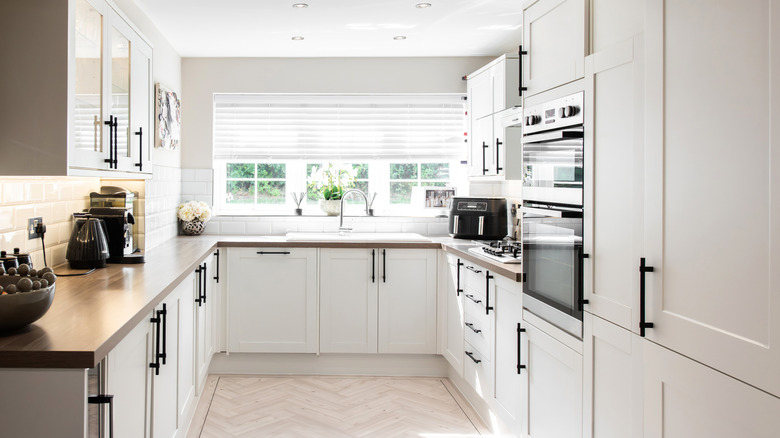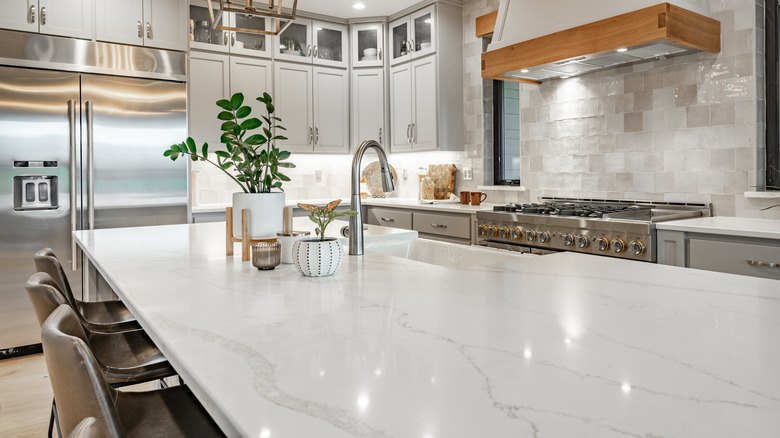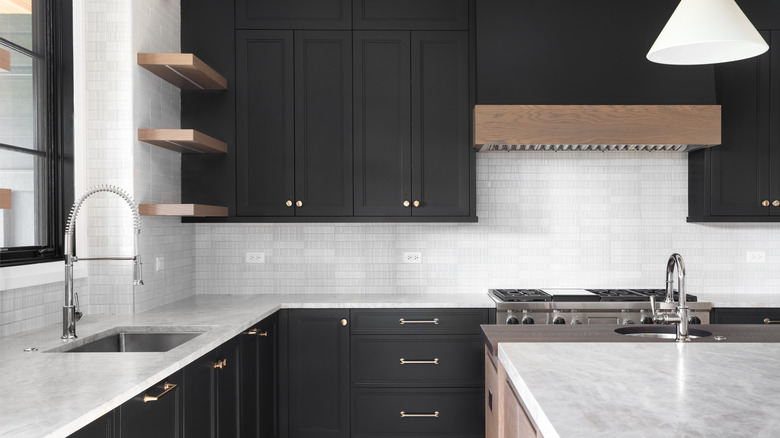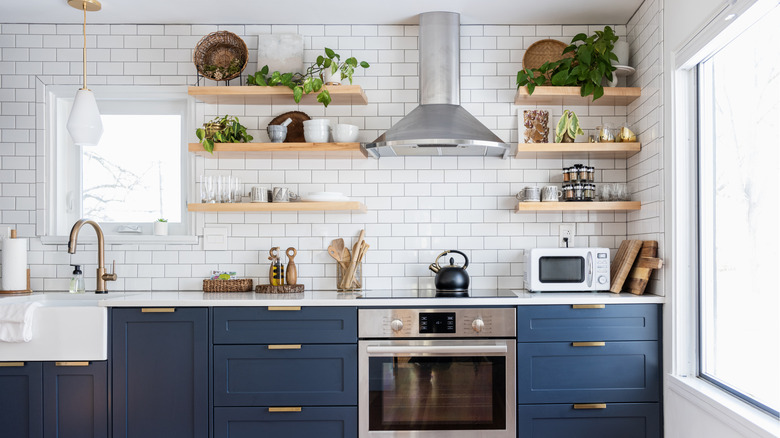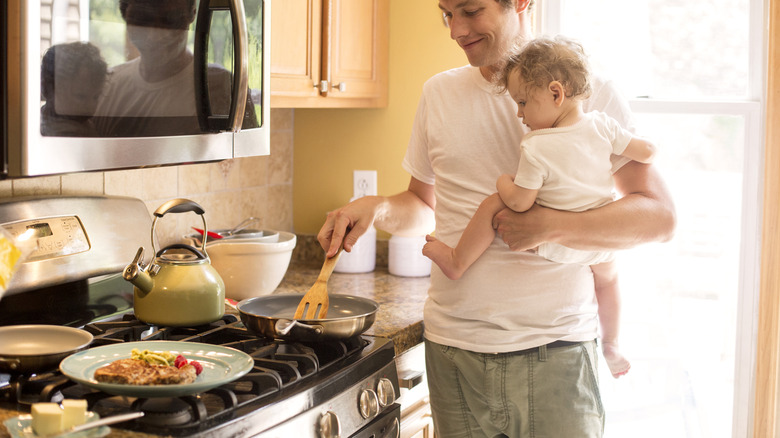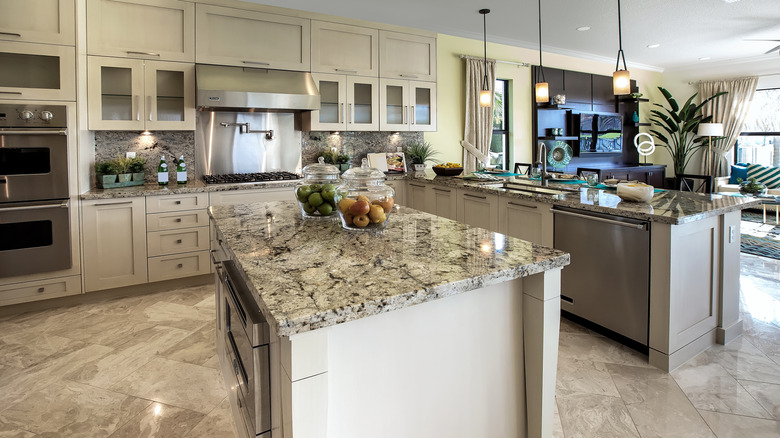5 Kitchen Features That Are Known To Be Hard (And Expensive) To Maintain
When you're designing a new kitchen, it's easy to only focus on the aesthetics. Don't forget about the importance of maintenance, though. You could spend a lot more time maintaining your kitchen than you want to if you choose the wrong materials. Marble countertops paired with high-gloss black cabinetry make a big impression, but they're not the easiest materials to maintain. You'll also spend a lot of time cleaning textured tiles and organizing open shelving. Even the type of stove you choose affects how easy your kitchen is to keep in good shape.
Kitchens are busy and often require more cleaning than other rooms because of cooking activities and heavy traffic. High-maintenance features keep you in the kitchen longer and take time away from your family and activities you want to do. Some of the worst offenders are materials that trap debris or soak up liquids, as your cooking activities often create crumbs and spills. Durability is a key factor when choosing materials because those kitchen features typically handle cleaning better than delicate materials.
If you love the look of a high-maintenance kitchen feature, you can often find similar options with easier upkeep. For example, quartz countertops come in stunning designs but are strong, durable, and nonporous, making them a beautiful, long-lasting alternative to porous marble countertops. Understanding the maintenance requirements of different materials in the kitchen helps you get the look you want without being stuck spending too much of your time and money on upkeep.
Porous countertop materials
The countertop material you choose affects how long your countertops last and how easy it is to maintain them. Because countertops get used frequently for preparing food, it's helpful to choose an option that holds up well against spills and stains. With so many beautiful countertop materials to choose from, it's important to understand which ones offer the most durability and easiest upkeep.
Looking at the differences between porous and nonporous countertop materials is a key factor in maintenance. Natural stone countertops, such as granite and marble, are porous materials, meaning they're covered in tiny holes that aren't visible to the naked eye. Concrete and wood butcher block countertops are also porous when they're unsealed. Those holes allow liquids and bacteria to seep into the countertops, which can cause stains over time. It's necessary to seal porous countertops regularly to prevent that from happening. Sealing adds to the cost, time, and labor to maintain your countertops. Having granite countertops professionally resealed costs between $170 and $350, and you typically need to repeat the process yearly.
For a lower-maintenance kitchen, choose nonporous countertop materials, which are solid with no microscopic pores. Because of the construction, these countertops don't require sealing and are usually durable with less risk of staining. Quartz offers a similar upscale look to natural stone and requires very little upkeep. Other options include solid surface, laminate, and stainless steel countertops.
High-gloss cabinets with intricate details
Your kitchen cabinets don't typically have direct contact with food, but they're still susceptible to fingerprints, grease, and splatters from your routine kitchen use. Cabinets also take a beating as you open and close them, which causes scratches and dings. The material cabinets are made from and the type of finish you choose affect how much smudges and imperfections show. Melamine, laminate, and thermofoil are options that are easy to wipe clean and maintain.
Stained wood cabinets hide normal wear and tear better with their grain texture than painted cabinets, which show every little scratch or nick. If you opt for paint, choose your finish type carefully. High-gloss finishes in dark colors tend to show every little fingerprint or smudge easily. You'll likely spend a lot more time wiping your cabinets to keep them looking clean. If you want the high-gloss look, opt for lighter colors, which tend to hide smudges better than darker hues. Even better, choose matte finishes if you want to cut your cleaning time.
Another factor to consider about your kitchen cabinets is the intricacy of the door design. Raised panels, louvers, beadboard, and intricate trim detailing all offer more places for grease and dirt to settle on your cabinet doors. It takes more time to scrub those areas clean because of all the little grooves and crannies. Keep your door design simple with slab or shaker-style cabinets. With large, flat surfaces and fewer details, these doors are easy to wipe clean.
Open shelves and space above cabinets
Using open shelving instead of traditional cabinets increases your cleaning duties. With everything out in the open, it's a prime target for grease, food particles, dirt, and bacteria floating around the kitchen. If you're using the shelves for items that touch food, they could become contaminated. Even if you primarily use the shelves for decor, you'll likely spend more time wiping down the items to remove the kitchen debris. Items could also fall and break more easily, which costs you more for replacement items.
Open shelves require extra organization to keep your kitchen looking tidy. When storing items that you use frequently on shelves, you need to spend more time putting them back precisely and keeping the shelves organized. You might need to invest in organizers to tidy up the shelves and extra decorations to fill out the shelves so they don't look too bare. Before committing to open shelving, consider the potential downsides and create a plan for keeping the area organized and clean.
Another time-consuming design choice is stopping your cabinets short of the ceiling. While the extra space gives you an area to decorate, it also becomes a spot for dirt and debris to settle. Since you can't see the top of the cabinets from the floor, you might not realize how dirty it gets. Designing cabinets that go all the way to the ceiling eliminates time-consuming cleaning and gives you more enclosed kitchen storage.
Gas stoves
This feature may be controversial for serious home cooks who prefer gas stoves. Gas offers many perks, including instant heat, consistent temperatures, and immediate heat adjustments, which allow for precision. However, a hidden downside of gas stovetops is the cleaning and maintenance they require. Unlike electric and induction ranges, gas stoves feature grates, burners, and nooks and crannies where food can collect. To thoroughly clean the range, you'll need to remove the grates and carefully clean all of the little crevices. If your pan boils over, you're left with a major mess and a potential safety risk if the liquids extinguish the flames.
An induction stove is an easy-to-clean alternative with a smooth, flat surface. Simply wipe up spills and food remnants when you're done cooking. It's even easier because of how induction cooktops work. Instead of heating the burner, induction cooking generates heat within special compatible cookware using an electromagnetic field. That keeps the stovetop around the burner much cooler, which reduces how baked-on food splatters get. Plus, you can wipe the stovetop sooner because it doesn't get as hot, giving the food less time to congeal on the surface.
Induction cooktops can also save you on energy costs. The energy efficiency of induction stoves is up to three times better than gas models. When compared to electric ranges, induction stoves are as much as 10% more efficient. You may need to buy new, induction-compatible cookware, but you can save money over time on energy costs.
Porous, rough-surfaced tiles
Tile in your kitchen adds a beautiful, durable option for floors and backsplashes, but not all tile materials are equally as beneficial in a kitchen. Natural stone tiles are often textured, creating crevices and dips where liquid, grease, and dirt can settle. Just like natural stone countertops, natural stone tiles are porous and require regular sealing to keep them clean and free of stains in a kitchen. Choosing large, smooth porcelain or ceramic tiles offers you the tiled look with a more durable option that doesn't require sealing. Porcelain tiles offer a slight advantage over ceramic when it comes to durability and resisting water absorption. The larger tiles also minimize the number of grout lines, which also present a challenge in the kitchen.
Traditional grout is porous and allows food particles and liquids to soak into the gaps between tiles, which can cause staining and discoloration. Regular cleaning is essential, but you need to be careful to avoid harsh chemicals and scouring cleaning tools to prevent damage to the grout lines. Even the easiest ways to clean grout are often time-consuming and involve scrubbing. Sealing the grout regularly can make it easier to clean. Another option is using epoxy grout, which is a nonporous option that doesn't require sealing.
